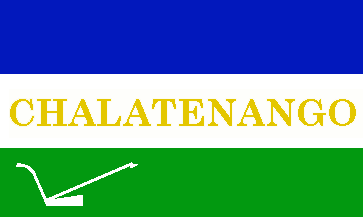 image by Fred Drews and Jaume Ollé, 18 August
1999
image by Fred Drews and Jaume Ollé, 18 August
1999
Last modified: 2021-08-25 by rob raeside
Keywords: chalatenango | el salvador |
Links: FOTW homepage |
search |
disclaimer and copyright |
write us |
mirrors
 image by Fred Drews and Jaume Ollé, 18 August
1999
image by Fred Drews and Jaume Ollé, 18 August
1999
See also:
Municipalities:
The Department of Chalatenango (192,786 inhabitants in 2007; 201,660 ha) is
the northernmost department of El Salvador, bordering Honduras. The Department
was established by a Law signed on 14 February 1855 by Colonel José María San
Martín (1811-1857), President of the Republic (1854-1856) and published on 1
March 1855 in the official gazette. Separated from the Department of Cuzcatlán,
it was made of the districts of Tejutla and Chalatenango, which had been
established in 1786. The district of Dulce Nombre de María was established on 15
July 1919.
Chalatenango is named for the Náhuat words "shal", "sand",
"at", "river", and "tenango", "valley", therefore meaning "the valley of the
sandy river". Other proposed meanings are "the sandy valley" or "a place
surrounded by water and sand". These possible etymologies all highlight the
local significance of river Lampa. Some historians believe that the place,
originally known as Xalatenango, was settled by the Chorti, Chorti-Pipile and
Lenca pre-Columbian people. The Spanish conquerors renamed the place to San Juan
Chalatenango, as a tribute to St. John the Baptist.
Chalatenango was once
famous for the production of indigo, a natural blue dye extracted from the
leaves of the true indigo shrub, Indigofera tinctoria L.. The All
Saints' Festival, celebrated from 26 October to 2 November since 1801, is
nicknamed the Indigo Festival, recalling that Chalatenango was once the main
place of trade of indigo in El Salvador. From the 16th to the late 19th century,
indigo was processed in a traditional device made of three tanks: the leaves
were pressed in the first tank for 12 hours, the coloured water was then beat
for one to three hours in the second tank, and the resulting dye was eventually
transferred manually to the third, smaller tank. In 1860, the department of
Chalatenango produced 30% of the indigo national export. The emergence of
synthetic dyes caused the decline of indigo, whose export from El Salvador was
superseded in 1879 by coffee export. Recent attempts to reactivate indigo
production have been unsuccessful.
http://www.chalatenangosv.com - Unofficial website
Ivan Sache,
16 May 2017
The flag of Chalatenango was designed by Patrocinio Córdova Aguilar, winner
of a public contest organized by the Department, whose results were proclaimed
on 27 April 1969. Official proclamation occurred on 15 May 1969 while the flag
was first hoisted on 29 May 1969. Originally adopted as the flag of the
Department, the flag is also used by the town of Chalatenango.
The flag
is horizontally divided blue-white-green, with "CHALATENANGO" written in golden
yellow letters in the white stripe and a white swing plow in the left part of
the green stripe. The original design also features the year of foundation of
the department, "1855", which was removed upon the jury's request.
Blue
represents the sky and El Salvador.
White represents peace.
Green
represents the mountains and the crops. The swing plow highlights the
Chalatenango as a rural department.
http://www.chalatenangosv.com/historia-bandera-de-chalatenango - Unofficial
website
The coat of arms, selected in the same contest, was designed by
Carmencita Urbina. The designer of the flag obtained the second prize for his
proposal of coat of arms. The arms feature a map of the department,
representations of cattle-breeding and agriculture, the mountain pinewoods, the
Colima bridge over river Lampa and the 5 de Noviembre barrage*.
http://www.chalatenangosv.com/simbolos-patrios-de-chalatenango - Unofficial
website
*The 5 de Noviembre barrage is managed by the Comisión Ejecutiva
Hidroeléctrica del Río Lempa (CEL), established on 3 October 1945 by a Decree of
the Executive published on 8 October 1945 in the official gazette, No. 139. This
started the use of the hydraulic resources for the electrification of the
country. River Lempa was surveyed in 1945-1947 to select the most suitable site,
with the advice of the American engineer George A. Fleming. Reorganised as an
autonomous entity by Decree No. 137, adopted on 18 September 1948 by the
National Assembly, the CEL contracted the Harza Engineering Company for the
design of the barrage. The building site was inaugurated on 21 June 1951 by
Lieutenant-
Colonel Oscar Osorio, President of the Republic. Inaugurated on
21 June 1954, the barrage was named for the date of the first call for national
independence, 5 November 1811. Another four barrages were subsequently built by
the CEL on river Lempa (Guajoyo, Cerrón Grande, and 15 de Septiembre).
http://www.cel.gob.sv - CEL website
Ivan Sache, 16 May 2017
ch.jpg) image from
www.guanaquin.com
image from
www.guanaquin.com